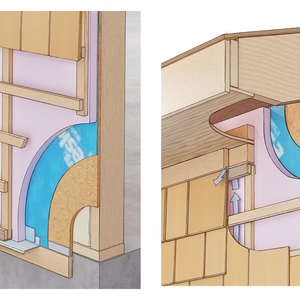*
——————————————————————————–
I’m wanting to build some interior door to replace the flush luan doors I put in when I was building the house 15 years ago and money was an issue.
I’ve never built any interior doors and would like to talk to someone that has…..I’m thinking a frame and panel affair, like a 6 panel or maybe something along that line. The material would be red oak, cause that’s what I like and have lots of, But I need some help on the mechanics..
I have an RBI door machine ( like a horizontal shaper) that makes kitchen cabinet doors pretty slick, and I have a set of Freeborn cutters for 1 3/4″ exterior door ( raised panel edges are 1/2″ instead of 1/4″ like on a regular cabinet door)…but would have to get a set for 1 3/8″ doors..but don’t feel real good about a cope and stick joint for 30×80 door….
Alwo have a 3hp router in a table, but no shaper…..
I’d really like to mortise/tenon the rails and stiles and peg the tenon with a walnut peg that would show on the door face where the top rail and the kick rail meet the stiles, but then I have the problem of how to do a cope/stick with that tenon sticking out of the rail..
I was figuring on making the stiles about 4 1/2″ or so wide…..do you think these need to be ripped into 2 pcs, growth rings reversed and glued back together to prevent a side stile from warpping ? I have some 6/4 I can do this with….or I could plane one face of some 4/4, glue two pcs together on the face and then run them down to 1 3/8″…or stop at 1 3/4″ and just make a thicker door…..got some nice quartersawn stuff I could do that with……
I’ve got 8 doors to build….
anybody got any advise here ??



















Replies
*
Tn, first of all, if your wood is dry enough it shouldn't warp, and if it's not dry enough doing glue-up tricks is a risky solution. Better to take your stock to a local kiln to have it dried down for you, to 6-8%, if it's not already there. Using the quartersawn stock for the frame members is a good idea.
Commonly available 6-panel doors usually have joints reinforced with dowels, which you can drill for either before or after the cope and stick are cut.
With your tooling, and what I will probably do someday when I have the time to build my dream home, is shown on the following attachment.
First, mill all frame pieces to final dimension, but leave some extra length, especially on the stiles.
Mill a groove to accept a spacer, which lines up with the tongue of the panel.
Use the 3hp router (plunge) or any other method to make your mortices.
Use a dado head or tenoning jig on the tablesaw to make the tenons.
Assemble frame and glue the spacers in.
Apply panel molding (with brads and maybe glue) to one side of door.
Flip door over, insert panel, and install panel molding to lock panel in place.
Hang door!
Good luck,
Mike
*Were tyhe stile meets the rail cut off the copeing tomake a square board and the end of your cope at a 45 mortise the stile and put a tennon on the rail cut the copeing onthe rail at45 . That way where the stile and rail meet will have flat shoulders and the tennon canbe as long as you want.
*Mike:Thanks for the good and detailed reply. What REALLY fired me up was the .jpg sketch you attached !! Wow...a picture really is worth a thousand words sometimes ! I assume you scaned it in and saved as a jpg file ??I have an "in shop" dehumidifier kiln and the lumber is in the 6-8% range ( See http://mybldg.com/hobbyist and look under articles if you'd like to see my homemade kiln)I hadn't thought of doing it your way, but may try that. I also have a Williams/Hussy moulder and could get knives for that panel moulding to do what ever I want. I just ordered knives to redo the window moulding around our Andersen casement windows to replace the pine that was the Andersen original ( and now 15 years worse for wear) with red oak.I also liked the reply below where I don't have to apply a separate panel moulding, but have some questions for Don...Thanks again !andy davenport
*Don: Yeah, I like that idea.....I really want to use a good, solid tenon off the rail, not dowels or a floating tenon....What do you use to cut the coping off the rail? Hand saw and hold it to a 90 as you approch the miter ? or bandsaw it up to the same point?How about cutters....do you use a set made for 1 3/8" doors or do you have some router bit tricks with a dado cut for the panel ?Thanksandy davenport
*If you're set on mortise & tennon joints you could cope and stick the whole thing, mortise the stiles AND the rails, and use loose tennons. But for interior doors, dowels will work just fine. "Sacreligous", I know, but I've never had any problems with them. I usually use 1/2" dowels about 3" into each member.
*I see absolutely nothing wrong with doing a full cope and stick then using well-fitted and properly glued floating tenons to join the stiles ans rails.Easier to build, and plenty darn strong.
*Adrian Wilson once told me a double biscuit joint (over and under) is real strong too. Cope+stick and double biscuits, that might be the ticket for those who can't stand the thought of using dowels.Probably at least as important as the type of joinery is the growth ring orientation on the stiles. Should be as close to vertical grain as you can find.
*Jim,There was a article in eithr FHB or FWW where a guy made interior doors using biscuits. I still dont know if they'd be strong enough. Id go with the floating tenons or dowels.
*The article Ron refers to was in FWW about 4 years ago. I don't have it in front of me, but if you're really curious give them a call. In that article, Taunton's CEO built some doors using multiple #20 biscuits. He tells me the doors hold up just fine. It is so tempting.... There have been a few other FWW articles over the years that compare the strength of various door joints.Wait for the next issue of FHB, #145, which you should get in a few weeks. In that issue, I edited an article on yet another approach to building interior doors. In a nutshell, use three layers for the frame. The outside layers are thicker, 5/8 or 3/4, and are configured as traditional stiles and rails. The inner layer is thin, 1/4 in. or so, whatever your panel-edge thickness is. The inner layer laps the joints between rails and stiles of the two outer layers, forming a cheater's tenon. Hold back the inner layer to make space for the panel edges. It looks bombproof to me, and it's dead simple to do. I built my front door in essentially the same manner, except all layers are 3/4 in. (The door's quarter-sawn white oak and 42-in. wide -- don't mess with the guy who can pick it up!)Andy
*Tn Andy , You can cut any way that you feel comfortable whaking on your new door parts. I used a hand saw and then sliped a chisel along the edge toclean it up. Also doing it this way your options are wide open as to cutter because yuo don't have to have a matching profile. Put in the panel dado first then run whatever profile you want on your door.
*Tn , the floating tennon is a good way to make a door . It allows you to use a stronger tennon if you are using weeker woods . I have made doors with dowels by drilling ,after they were together ,with a long bit then I squirted glue in and hammered in the dowel rods. Cut flush paint and no one knows.
*I remember an article like that...If I recall, didn't the author go with 4 biscuits per joint?There was another "expose" on joint strength...not sure if it was affiliated with the same piece of print. I remember biscuited joints being pulled apart, and it was the wood itself that failed, not the biscuit.Here's a question for those of you that know more about adhesives than me:If you did a door with biscuits and floating panels, do you think the yellow glue would suffer from a bit of creep over the years from the weight? I could see it working with a secured panel, but a floating panel?
*I don't dare secure panels for fear of seasonal movement breaking something. I always float them. I can see how folks would argue in favor of biscuits, they have a lot of surface. But to me, it seems like they put too much stress on too small an area of the wood they are glued to. I still like dowels. What's this about yellow glue creeping? That stuff dries hard as a whore's heart.
*So what does he do, rabit the front or back to conceal the edge of the center piece? That would be slick, then you could even use plywood for that center layer. That WOULD be bomb proof, couldn't sag, either.
*You'll see in a week or two, Jim. He stops the centerpiece say, 1 1/2 in. from the outside edge of the stiles, and fills in the edge with a long piece whose grain runs parallel to the stile. BTW, yellow glue does creep. I used urea/formaldahyde glue for my front door. That stuff sets so hard that it can cut you! No creep whatsoever. I doubt that glue creep would be an issue for most interior doors, though. I'm thinking of using the center-layer method to make my own interior doors, and since I'm using plywood panels, just gluing them in as you suggest. Simple, fast and strong.Andy
*I have no heartache at all securing the panels if they are made of a stable material...something like ply. I could justify using biscuits (no gravy) with secured panels...I'd still opt for a floating tenon with floating panels, though.
*I've made a slew of custom interior doors, and have used all the above methods, except for straight cope & stick. They've all worked just fine. I think FHB had an article on cope & stick with long tenons. I don't know, maybe I saw it on Norm's show. Anyway, the profile was sawn off the stiles with a table saw. First cutting the miters with the miter gauge and then ripping from both sides. I've finished them off with with a flush cutting saw and chisle. Works great, and, with sguare walnut pins, would look great too.You didn't mention if you had a mortising machine or not. T'would be handy here...Of all, I prefer loose tenons, and the walnut pins would be decoration...Good luck, BB
*Andy , Are you saying that you use a sheet of ply , say 34" x 78" for the "core" of the door and then sort of apply the stiles and rails? I had been kicking around an idea like that for my front door,only with a stainless steel sheet for the core and then make stiles ,rails, and panels for each side.
*Don, No, I didn't say anything about plywood....someone else here suggested a plywood spline in the panel groove and using a moulding on either side to hold the panel in....WHY would you use a sheet of stainless steel in the core of a door ??and how would you get the wood fastened to the wood on the other side of that sheet ?? just curious....You trying to make a bullet proof door ?? :)
*More or less. I was thinking that it would not rust and would be fairly stable. I don't know how I would fasten the wood on both sides. It was just a thought one day . The idea was to have some advantage of the strength of steel and the look of wood.The problem Isee with steel core is moisture not drying and then faster rot on the exterior .